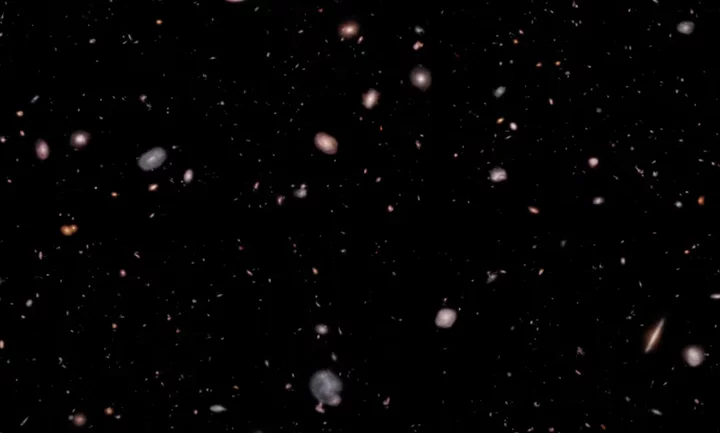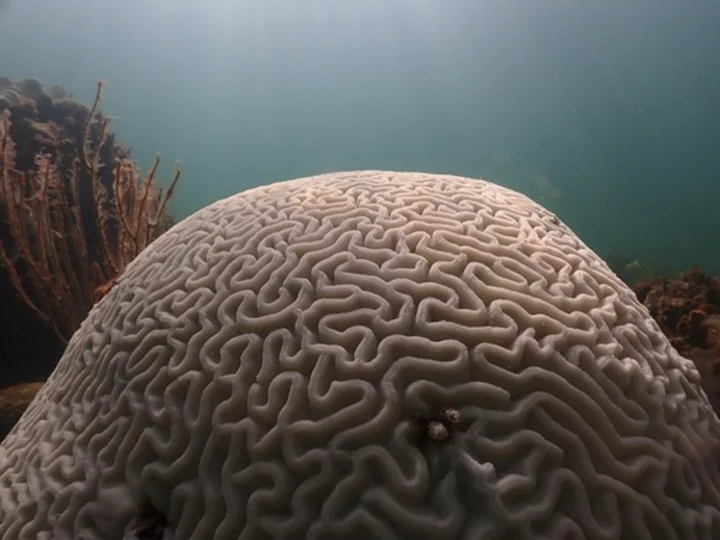Intergalactic travel is technically impossible today. But with the most technologically advanced space telescope, you can still experience the great cosmic expanse.
The James Webb Space Telescope — the observatory with an over 21-foot-wide mirror orbiting 1 million miles from Earth — collects bounties of light, allowing it to capture detailed views of galaxies billions of light-years away. Using this imagery, astronomers created a visualization of galaxies seen during a survey of the early universe, called CEERS, short for "Cosmic Evolution Early Release Science."
The one-minute flight video, shown below, is well worth your time:
SEE ALSO: Spectacular Webb telescope image reveals things scientists can't explainYou begin the journey by passing through "nearby galaxies," located several billion light-years from Earth. You'll spot many spiral galaxies, similar to our Milky Way.
You'll travel through time, billions of years, eventually arriving at one of the earliest galaxies ever formed, called "Maisie’s Galaxy." It's a blurrier red object, owing to its great distance away. You're seeing how it looked a whopping 13.4 billion years ago, just some 390 million years after the universe formed. These are the type of objects astronomers really want to see.
"This observatory just opens up this entire period of time for us to study," Rebecca Larson, an astronomer at the Rochester Institute of Technology and one of the CEERS researchers, said in a statement. "We couldn’t study galaxies like Maisie’s before because we couldn’t see them. Now, not only are we able to find them in our images, we’re able to find out what they’re made of and if they differ from the galaxies that we see close by."
Enjoy the trip. As NASA explains: "Each second amounts to traveling 200 million light-years into the data set, and seeing 200 million years further into the past."
In that video, you're flying through just a tiny patch of space, a part of the "Extended Groth Strip" located between the constellations Ursa Major and Boötes (the Big Dipper makes up part of Ursa Major).
Many of the closer galaxies to us contain hundreds of billions of stars. And each of those stars likely contain planets...
An artist's conception of the James Webb Space Telescope viewing the cosmos with its giant mirror. Credit: NASAThe Webb telescope's powerful abilities
The Webb telescope — a scientific collaboration between NASA, the ESA, and the Canadian Space Agency — is designed to peer into the deepest cosmos and reveal unprecedented insights about the early universe. But it's also peering at intriguing planets in our galaxy, and even the planets in our solar system.
Want more science and tech news delivered straight to your inbox? Sign up for Mashable's Light Speed newsletter today.
Here's how Webb, which just celebrated a year of science operations, is achieving unparalleled feats, and likely will for decades:
Giant mirror: Webb's mirror, which captures light, is over 21 feet across. That's over two and a half times larger than the Hubble Space Telescope's mirror. Capturing more light allows Webb to see more distant, ancient objects. As described above, the telescope is peering at stars and galaxies that formed over 13 billion years ago, just a few hundred million years after the Big Bang.
"We're going to see the very first stars and galaxies that ever formed," Jean Creighton, an astronomer and the director of the Manfred Olson Planetarium at the University of Wisconsin–Milwaukee, told Mashable in 2021.
Infrared view: Unlike Hubble, which largely views light that's visible to us, Webb is primarily an infrared telescope, meaning it views light in the infrared spectrum. This allows us to see far more of the universe. Infrared has longer wavelengths than visible light, so the light waves more efficiently slip through cosmic clouds; the light doesn't as often collide with and get scattered by these densely packed particles. Ultimately, Webb's infrared eyesight can penetrate places Hubble can't.
"It lifts the veil," said Creighton.
Peering into distant exoplanets: The Webb telescope carries specialized equipment called spectrometers that will revolutionize our understanding of these far-off worlds. The instruments can decipher what molecules (such as water, carbon dioxide, and methane) exist in the atmospheres of distant exoplanets — be it gas giants or smaller rocky worlds. Webb will look at exoplanets in the Milky Way galaxy. Who knows what we'll find?
"We might learn things we never thought about," Mercedes López-Morales, an exoplanet researcher and astrophysicist at the Center for Astrophysics-Harvard & Smithsonian, told Mashable in 2021.
Already, astronomers have successfully found intriguing chemical reactions on a planet 700 light-years away, and the observatory has started looking at one of the most anticipated places in the cosmos: the rocky, Earth-sized planets of the TRAPPIST solar system.
This story has been updated with more information about the James Webb Space Telescope.









